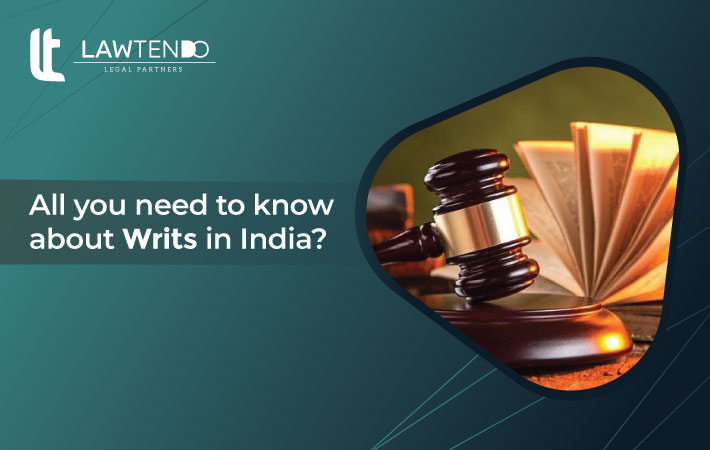Want to file a Writ Petition? Here’s all you need to know

Date : 31 Aug, 2021
Post By Bhupender Tanwar
Under Article 32 of the Indian Constitution, the Supreme Court has the authority to issue a Writ. When a citizen's Fundamental Right is violated, he or she has the right to approach the Supreme Court directly to have his or her rights enforced, and the Court can issue the relevant Writ. Article 226 gives the Indian High Courts the power to issue Writs. While citizens can only go to the Supreme Court if their fundamental rights have been violated, they can also go to the High Court for Writs in cases where their fundamental rights have not been infringed. Types of writ Courts can issue five different sorts of writs under the Indian Constitution. Mandamus Habeas Corpus Certiorari Prohibition Quo Warranto Mandamus: The Indian Constitution provides for a crucial Writ called Mandamus. In this the Superior Courts use the Writ of Mandamus to command the Inferior Courts to do something or not do something. This order can be granted to any sort of administrative authority, including an inferior tribunal, board, corporation, or corporation. Because the Supreme Court is India's highest court, it has the authority to issue a Writ of Mandamus against the High Court, despite the fact that the High Courts have the authority to do so under Article 226. As a result, under Article 226 of the Constitution, a High Court can only issue this Writ to inferior courts, such as a district trial court. This Writ can be used to enforce a legal or official requirement. The Judge of the Court, for example, has a duty to follow natural justice principles, and if the Judge fails to do so, the Superior Court might issue a Writ to ensure that this duty is fulfilled. This Writ can be used to enforce a legal or official requirement. The Judge of the Court, for example, has a duty to follow natural justice principles, and if the Judge fails to do so, the Superior Court might issue a Writ to ensure that this duty is fulfilled. Example: A is a government employee who has a legal obligation to fulfil towards B, but he fails to do so. B is harmed by A's failure to perform and goes to the High Court to seek A's compliance. The High Court will issue a Writ of Mandamus if it is convinced that B's cause is genuine and that there is a duty that must be performed. If, on the other hand, A were a businessman who owed B a favour but failed to fulfil it, In this scenario, A is unable to seek Mandamus from the Court since a Writ of Mandamus cannot be granted against a private individual. case- A petition was filed in the High Court in the case of Vijaya Mehta v. State of Rajasthan, requesting that the State fulfil its obligation of forming a commission to investigate climate change and floods in the state. The Court determined that the State Government would be required to appoint a commission only if the Legislature enacted a resolution, and that it was a discretionary rather than a statutory obligation, hence no Writ of Mandamus was issued in this case. Consult the best lawyer online Habeas Corpus: Courts grant Writs of Habeas Corpus in circumstances where someone is being detained illegally. Habeas Corpus is a legal term that means "to have the body," and it is one of the most powerful defences a detainee can use. The person or authority who has detained or restricted another person is required to present that person before the Court under this Writ. The detaining person is required by the Court to provide the grounds for the person's detention, and if he fails to do so, the person will be freed by the Court immediately. B, a police officer, wrongfully detains A. In this case, a letter was sent to the High Court. The High Court summons B and A, and inquires as to why A is being held in custody. A will be allowed to leave if B fails to present a valid reason for A's detention. Although the goal of this Writ is to prevent a person from being detained, it will only be effective if the detention or restriction is illegal. This Writ will not be granted if the Court deems that the reasons for detention are reasonable. Furthermore, if a person is detained by the Court, it is not wrongful detention, and this Writ cannot be issued.
Certiorari: The writ of Certiorari literally means "to certify" or "to notify." This writ is issued by a higher court to a lower court or tribunal, instructing them to either transfer or quash a case standing before them. It is issued due to an overreach of authority, a lack of authority, or a legal error. It not only avoids, but also corrects, judicial errors. The purpose of these writs is to prohibit public officials from abusing their power. These writs were formerly only granted to judicial and quasi-judicial authorities. Certiorari and prohibition are common remedies for judicial review of quasi-judicial and administrative actions that impair rights. Get in touch with the best lawyer online Prohibition: The term 'Stay Order' refers to the Writ of Prohibition, which means to prohibit or stop something. When a subordinate court or body attempts to overstep its bounds or powers, this writ is issued. A writ of prohibition is an order issued by a High Court or the Supreme Court to a lower court or quasi-judicial body banning it from continuing proceedings in a case in which it lacks jurisdiction. Proceedings at the lower court, for example, come to a halt after this writ has been issued. Prohibition vs. Certiorari: What's the Difference? While the writ of prohibition can be used while the case is still in progress, the writ of certiorari can only be used after the order or decision has been made. Both writs are issued in the name of legal entities. Quo Warranto: When a private person assumes an office over which he has no authority, the courts issue a Writ of Quo Warranto against him. Quo Warranto, which literally means "by what authority," is a useful tool for preventing people from assuming positions of power. As an example, assumes the position of sub-inspector while having no qualifications for the position. In this case, a Writ of Quo Warranto can be issued against A, putting his power to control the office of sub-inspector into question. Nobody can compel the court to issue this Writ since the power to do so is discretionary. Conclusion: The Supreme Court and the High Court have issued the following five categories of writs under Articles 32 and 226 of the constitution. Certiorari and Mandamus are the two most regularly requested writs to control the conduct of administrative agencies, with Habeas corpus and Quo warranto being limited to specific situations. These Writs are court orders that direct a public authority to perform a certain act and all of these writs are useful tools for upholding people's rights and requiring governments to carry out their legal obligations.





